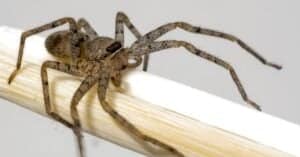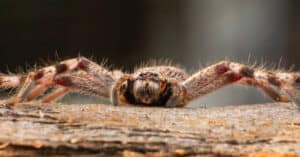With everything you hear about spiders and how terrible they are, it might sound insane to actually want one as a pet. There are many types of these tiny spiders, and with that comes varying care and costs. The internet is filled with groups, forums, and websites boasting care tips regarding which spiders make the best pets.
Millions of people have flocked to the internet to watch countless videos of adorable jumping spiders with tiny pretend voices saying the cutest things. Many people who previously had arachniphobia have said their unshakable fear was pushed aside once they watched the videos and realized how sweet and lovable the tiny jumping spiders were and slowly decided they too, wanted a jumping spider of their own as their pet. Let’s take a deeper look into what goes into having these adorable arachnids as a pet. Maybe you’ll even want your very own!
Jumping Spiders Have Taken Over Social Media
Jumping spiders have hopped, skipped, and jumped 10 times their body length all the way into our hearts. There is a constant fluctuation of “it” pets gaining attention on social media such as Instagram, Facebook, and TikTok. But what makes these little arachnids so popular all of a sudden, and who are the people promoting their lineage and cuteness?
Melissa Mariner of Spooderhood Spiders has gained a massive following in the short two-and-a-half years she has been in business.
When asked about her business and success, Mariner had this to say, “Jumping spiders make amazing pets. Not only are they super friendly, docile, and curious little creatures, but they have the ability to bond with their humans. People don’t call them “web puppies” for nothing! They are magical little beings changing minds about the 8-legged “beasts” of the world one person at a time. All you have to do is meet one to see how special they are.”
When asked about the difficulty level of a pet jumping spider’s care, Mariner answered, “Their care is extremely easy. They require an enclosure fit for their size (no bigger than a 4x4x8 inch arboreal enclosure for a typical adult), a mist of water per day in their home for drinking/humidity, and feeding 2-3 times per week, depending on age.”
Types of Jumping Spiders for Pets
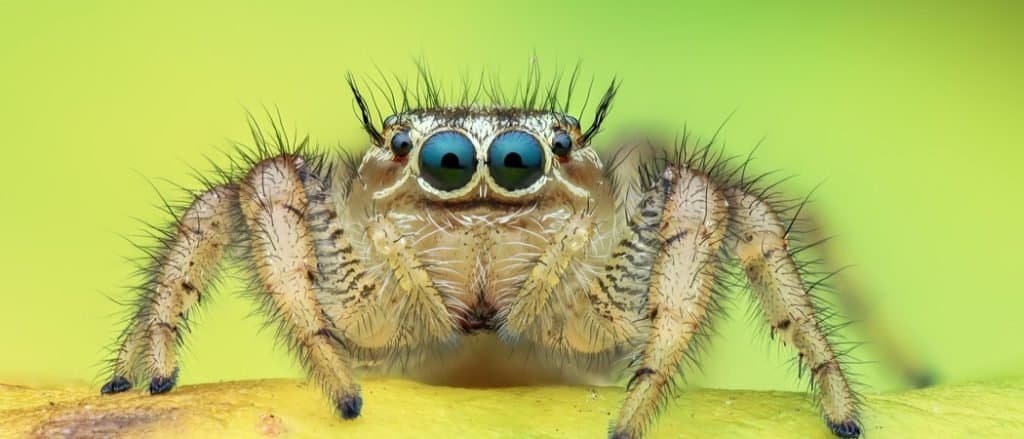
Deciding on the type of jumping spider is easy once you know what to look for.
©Tran The Ngoc/Shutterstock.com
Maybe you’ve watched tons of videos and done plenty of research online like any good pet parent would do before deciding to bring a pet home. Now you’re ready to consider the different types of spiders available. Let’s take a look at some of the popular types breeders keep in stock, with plenty of color variations to choose from.
Regal Jumping Spider (Phidippus regius)
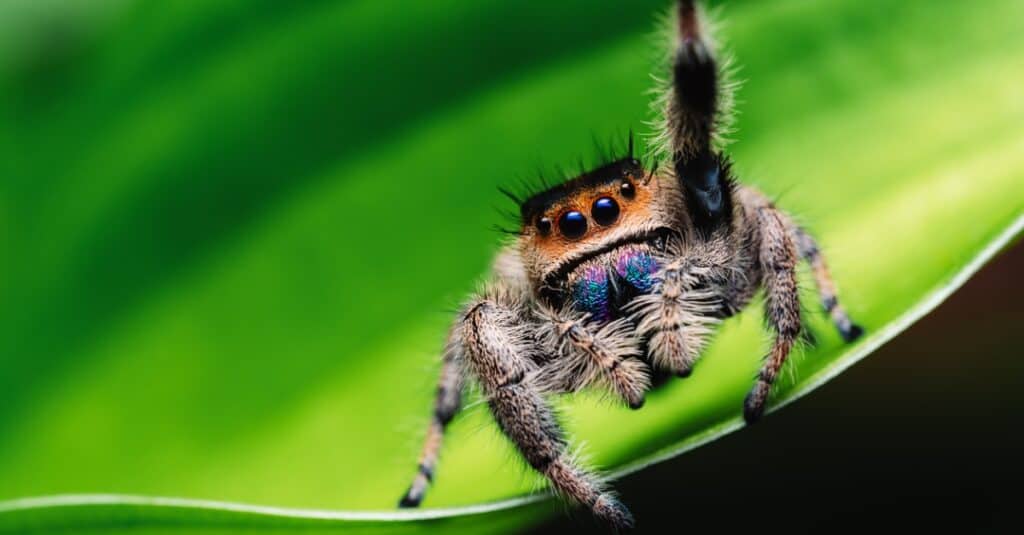
The regal jumping spider is very cute and fuzzy.
©iStock.com/Jan Rozehnal
Cost
$20 – 75
Appearance
The regal jumping spider is one of the largest types of jumping spider available. They typically range from 6 – 22 millimeters in length. The males and females are sexually dimorphic, meaning they look different, and once maturity is reached, are fairly easy to identify as such.
As far as coloring, the females can be a variety of colors and shades, all of which can change each time they molt. When purchasing a jumping spider, understand that unless you adopt an adult, the coloring cannot be guaranteed. The females can be grey, tan, black, orange, pinkish tan, peach, white, and any variation in between. They all have intricate “tribal-looking” markings on the top of their abdomens. Some say it can look like a heart or a tiki mask. Their pedipalps are very fluffy and give them an adorable, cuddly appearance. They use these to flequently wash their faces which can be endearing to those watching. The female’s chelicerae is much smaller than the male’s but is also brightly colored in pinks, oranges, blues, greens, and many other colors and variations. They can even be multiple shades at once.
Males, on the other hand, can easily be confused with a close relative, the bold jumping spider (Phiddipus audax), due to the black and white coloring they share. The males can be identified by their large front arms and their large, brightly colored chelicerae. Their pedipalps, when mature, are their sex organ and take on a boxing glove or lightbulb appearance.
Behavior
The regal jumping spiders are the friendliest and most inquisitive spiders. They are fantastic for those just starting out in the jumping spider hobby. Once they are familiar with your voice and presence, they may grow to trust you enough to climb aboard your hand. They enjoy looking around and jumping from place to place as a form of play. Play gyms are one way you can safely get your friend out and enjoy. Others choose to get the spiders out on their beds since the fall risk is much less, meaning the spider will not become injured if it falls.
Care
These are easy spiders to care for if you know how in advance. Depending on their age and size, they require appropriate food. This could be mealworms, flies or fly spikes, wax worms, hornworms, crickets (from a trusted source), or flightless fruitflies. Dead insects need to be removed frequently.
Their housing needs to be the appropriate size for their age and size, with most not exceeding 8 x 6 inches. Smaller, younger spiders must be housed in smaller containers to avoid becoming fearful and not being able to catch their prey. Their enclosures should be misted with bottled water without additives daily on one side of the enclosure. This helps support the humidity and supply the spider with water for drinking. The temperature of the enclosure should not go below 68 degrees and never above 80 degrees. Lighting for daylight hours is important, just as is darkness for nighttime. These are diurnal spiders that sleep in small hammocks, which they make from webbing, once it becomes dark but are up at sunrise daily.
Bold Jumping Spider (Phidippus audax)
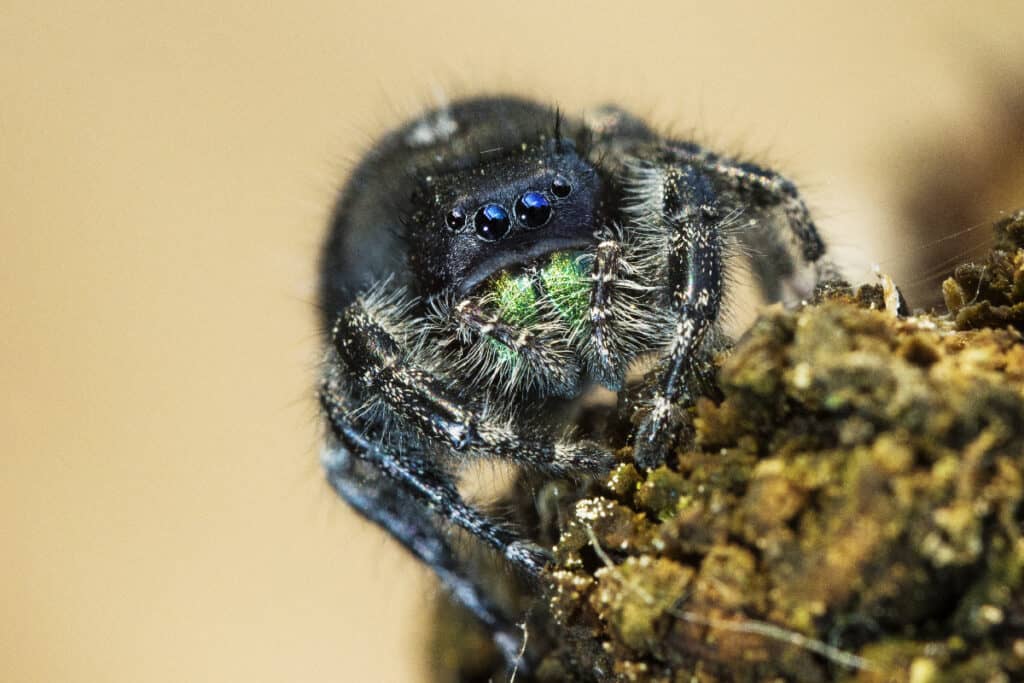
Bold jumping spiders’ mannerisms are much the same as the regal jumping spiders.
©Mircea Costina/Shutterstock.com
Cost
$20 – 75
Appearance
Bold jumping spiders are slightly smaller than regals, though this isn’t always true. The bold jumping spiders measure 8 – 18 millimeters long. Typically the females are a slight amount larger. The females are black, like the males, though some may have a greyish color.
The white spots on the backs of the bold jumping spiders can be pinkish, yellow, or orange in color, which is a color variation called bryantae. It is commonly found on juvenile spiders, and the color will molt to white upon the spider reaching maturity. The females have fluffy pedipalps, while the males are lightbulb-shaped at the ends upon reaching maturity. The males look very similar to a male regal jumping spider.
Behavior
Bold jumping spiders can be a bit more skittish than the regals but can warm up with patience and kindness. This doesn’t mean all are that way since no two spiders are the same. Plenty of bold jumping spiders are friendlier than regals and vice versa. They act similarly to the regals but are generally not as curious about humans. They are excellent hunters and spend time sizing their prey up and stalking it before making the final lunge to catch it. Bold jumping spiders will come out and enjoy playing gyms and exploring on your bed or you once they feel at ease.
Care
Like the regals, these spiders require minimal care. They do require the correct size enclosure and food. When purchasing through a reputable breeder, they will be able to guide you in the right direction with any of your needs. Some even provide enclosures along with the spiders, making that step easy. The temperature should be between 70 -80 to keep them the most active. They slow down considerably when cold. If they are kept in direct sunlight, their enclosure can overheat and kill them, but indirect sunlight through a window is safe. All types of jumping spiders love the sun and sunbathing.
Making sure to mist their enclosure wall daily is important. All jumping spiders are arboreal, meaning they cannot climb high enough, in their opinion. They will always want to seek out the highest spot they can in their enclosure to make a hammock. It is important to leave the top area open and uncluttered enough that they can find a cozy little spot to make their bed. They will sleep in it nightly and have a pretty strict sleep and wake schedule, which keeps them happy in their own way.
Canopy Jumping Spider (Phidippus otiosus)
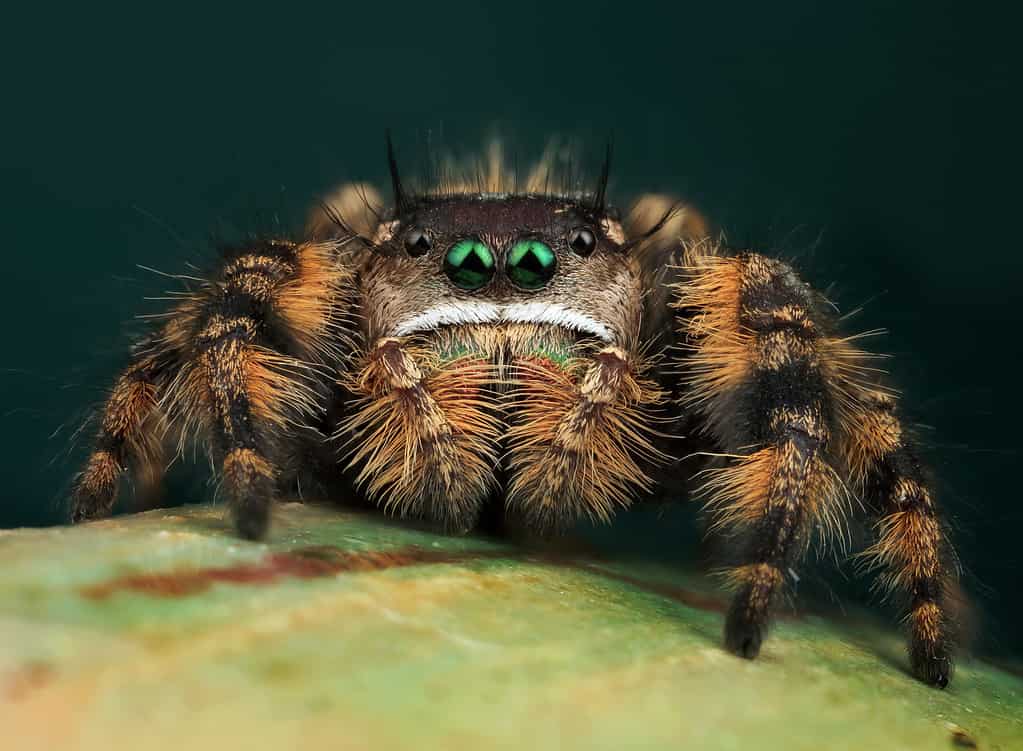
Canopy jumping spiders (
Phidippus otiosus) can breed with regal jumping spiders and create hybrids only seen in Florida.
©Andres moline / CC BY-SA 4.0 – License
Cost
$20 – 75
Appearance
The canopy jumping spider looks very much like a regal, but it is slightly smaller. They are 8 – 18 millimeters long, like the bold jumping spider. The females are slightly larger than the males. They both have brightly colored chelicerae, as with all jumping spiders. The canopy jumping spiders chelicerae can be purple, green, blue, or a combination of colors. This and their body’s coloring can change with every molt until they reach maturity, and it is a bit like changing clothes.
The body of the female spider can vary greatly in color and sometimes be two or more colors. The most common colors are tan, chocolate brown, peach, white, orange, or black. Along their upper abdomen or “back” as we know it, the spiders have beautiful intricate markings and also a really neat wavy line display giving them a distinct look. Their stripped legs come in colors found on their bodies. The eyelashes are typically very long, stand straight up, and are black. This gives them a slightly different look than the regals.
Behavior
With all spiders and people, no two are alike. Personalities can vary a bit at different stages of their lives and molts, as well. Juvenile spiders are friendly and very fast, which is why it’s always best to handle them while sitting on your bed. Adult spiders might become spooked just as fast as juveniles in some cases.
The canopy jumping spiders share the common behavior and personality traits of the bold and regal jumping spiders. They, too, enjoy walking along your arms and shirt or playing on a spider play gym. All jumping spiders can be fast, so it’s best to move slowly with them so as not to scare them into running. The spiders pick up the vibrations from our individual voices on the hairs along their body, which is how they listen. Jumping spiders love listening to you speak quietly to them and will tilt their heads and gaze at your face. This is also a great way to gain their trust.
Care
Canopy jumping spiders require the same type of basic care as any of the other jumping spiders. It is important to keep their habitat a bit more humid than some of the other jumping spiders. By misting daily, you are providing adequate humidity. They enjoy the same food choices as the other spiders in this article though it’s important to avoid wild-caught insects in case they can harm your spider through toxins in their system or on the outside of their bodies. It is also entirely possible outdoor insects can carry harmful parasites that may kill your precious pet. This is why research is so important when adopting and caring for a spider of any kind.
Jumping spiders really enjoy artificial plants and leaves. You may choose to attach to the sides, bottom, and top of the enclosure to suit their needs best. They really enjoy hiding, so try to give them more than ample places to do so and don’t become worried or disturb them when they hide. Think of it as your pet having a bit of “spider-alone time.”
Don’t Worry
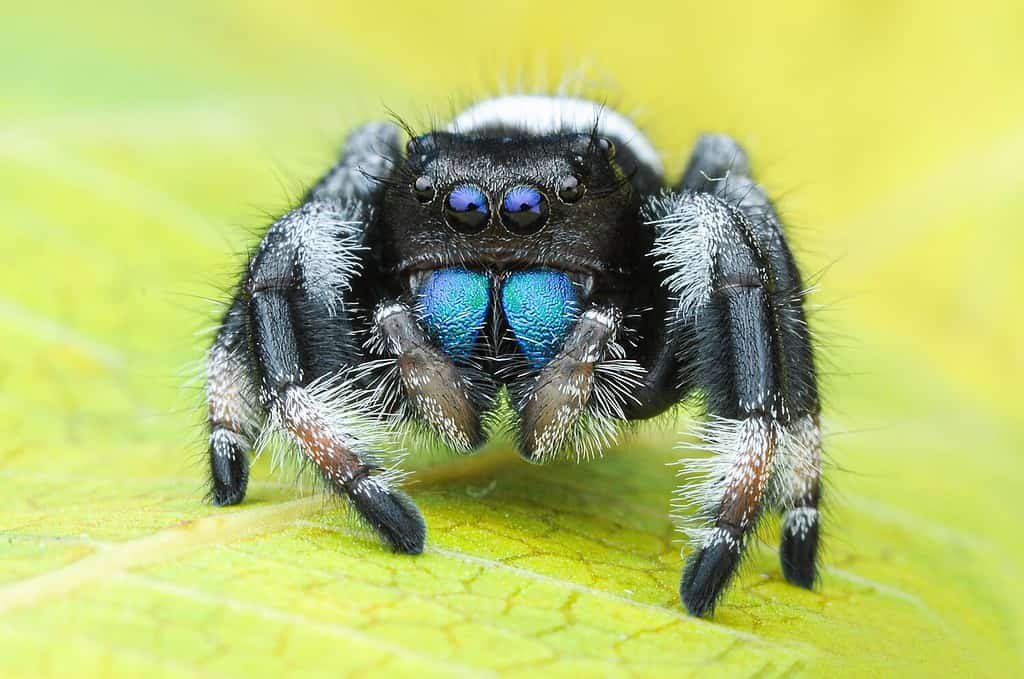
This male regal jumping spider may be larger than many of the females.
©Arif Supriyadi/Shutterstock.com
Whew! It may seem like that is a lot of information to digest. With any pet, it is best to know everything upfront, both good and bad. You certainly don’t want to wait until you have an issue before reaching out to a breeder for advice. Take your time and do plenty of research online beforehand.
Spend some time looking up the cost of different insects and see if there is anywhere locally you can get them. If there isn’t, you will be looking at two-day shipping speeds at minimum, and costs for shipping overnight are expensive. This is also how your spider will ship. It is best not to order in the summer unless it is an early morning overnight delivery that you will be there to get inside. Most places throughout the US are hot in the summer, and you do not want your spider to die in transport. Reputable breeders will not ship when it is hot. This also goes for temperatures that are very cold.
A Lovely But Short Time
More than anything else, know that with time comes experience. Once you adopt one jumping spider, you will be inquiring about adopting more before long. A very important bit of information is to enjoy your time with your jumping spider as often as you can. Sadly, they have short lives, and depending on what stage of life you adopt them at, they might only be with you for a short time. Most jumping spiders live for one or two years. If you are extra lucky, you might get three years out of the relationship, but that isn’t all that common. Let them be happy and comfortable in the way that suits them best, and just be glad you’ve been a spectator for the event.
Facts About Owning Jumping Spiders
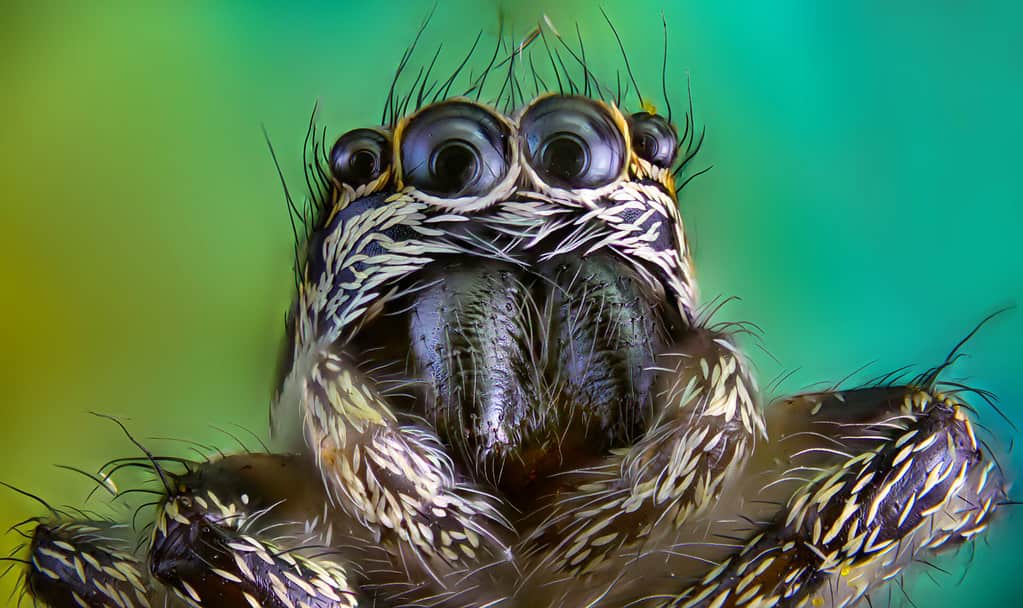
This is an amazing macro image of a Zebra Jumping Spider (
Salticus scenicus).
©Andrei Savitsky / CC BY-SA 4.0 – License
- Topical flea medications on your pets can be a death sentence for your spiders. All pets have dander, and their dander will contain traces of the chemicals used. Opt for chewable flea medication for your furry friends. Also, it’s best to keep your spidey friends in a separate room from the ur kids if possible.
- You don’t have to spend hundreds on a fancy-themed enclosure unless you want to do so. A regular enclosure with fake plants and a natural look will make your spider happier and cost massively less. It can be difficult to turn down some of the amazing pre-made enclosures out there. There seems to be a theme for everyone.
- There are tons of fantastic jumping spiders that make great pets for most people. However, it is best to start simple and level up as you learn. Choosing a tiny species of jumping spider as your first could end in tragedy, or you might accidentally lose them.
- Do not choose to breed your jumping spiders unless you are okay with thousands of baby spiders. Female spiders lay infertile eggs when they have not mated. It is the female spider’s natural cycle to produce eggs, fertile or not. If you choose to breed her, she will lay up to 10 egg sacs over the course of her life. Each egg sac can contain 1000 eggs. It is not easy to care for and separate microscopic baby-jumping spiders.
- Male jumping spiders do not live nearly as long as females. After reaching maturity, they may last a year at most.
- Male jumping spiders are every bit as hilarious, curious, and friendly as females. They are not as brightly colored and sadly do not find homes as frequently as females. Consider starting with an adorable male jumping spider. They deserve wonderful homes, just like the females.
A Few More Tips
- If you choose to catch a wild jumping spider, you might have a gravid (pregnant) spider who will lay tons of egg sacs. If you are new to the hobby, this can become overwhelming and is not recommended. You might also have a spider that has mites or other parasites, which you do not want. It is advised to purchase your spiders through reputable breeders who supply captive-bred spiders. You do not want to end up with a fertile gravid female for your first spider.
- Fragrances, oils, wax burners, candles, incense, spray air fresheners, and others can be deadly to jumping spiders and should be avoided.
- Always use a spray bottle that produces a very fine mist. Jumping spiders have book lungs, which are on the outside of their bodies. If they hover over a large water droplet, they can drown. Never use cotton balls or anything left in the enclosure. They quickly pick up bacteria and are unsanitary.
- Always use dishwasher-safe Modge Podge or something similar to seal any wood before putting it in the enclosure. The wood will mold, and spiders are extremely sensitive to mold, which can kill them. Be mindful of what you use to seal the wood. It must be nontoxic and be given a lengthy amount of time to cure and the scent to dissipate before putting it in any enclosure containing a spider.
- Spiders cannot be housed together. They will turn cannibalistic if they are hungry or will kill the other spider because they are territorial loners. Slings (newborn and baby spiders) can be kept with their mother spider for a while and can be kept with siblings for a longer amount of time. They can also turn cannibalistic if hungry or bored.
- Do not house spiders with any other type of animal. Depending on what you want to keep together, it’s not a good idea. The only creatures fairly safe to house with your spiders are springtails or isopods. Those are only needed in all-natural, climate-controlled enclosures with dirt and live plants.
The photo featured at the top of this post is © OBX Wildlife/Shutterstock.com
Thank you for reading! Have some feedback for us? Contact the AZ Animals editorial team.




